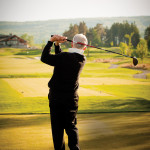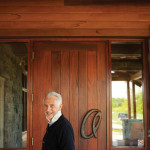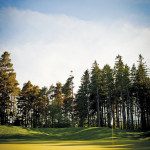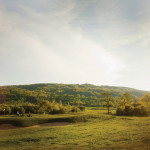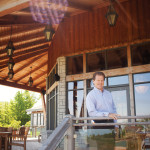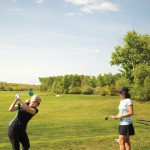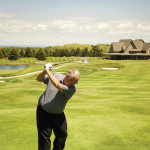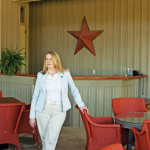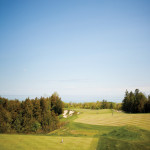Innovation is the name of the game as our local golf clubs compete for new members and new players
by Janet Lees, photography by Kristie & Brenden Woods
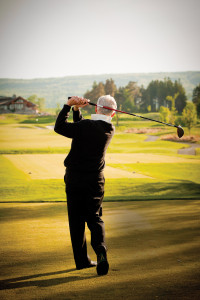
Does golf have a future? That’s the big question every publication from Golf Digest to The New York Times and the Globe & Mail has been asking for the past several years.
On the surface, the facts look bleak: golf has lost five million players worldwide since 2005, and some estimates claim players are continuing to walk away at a rate of one million per year. About 18 per cent of the 5.7 million golfers in Canada take up the game and then quit in a given year. The reasons boil down to cost, time, difficulty and elitism: golf is too expensive, it takes too long, it’s too hard to play and has too many annoying rules.
To tackle those perceptions, some courses in the U.S. and Canada are introducing drastic and bizarre variations on the game, from ‘foot golf’ – a blend of soccer and golf – to quadrupling the size of the hole.
But are gimmicks like pizza-sized holes and soccer balls on the fairway simply digging golf a bigger hole (both literally and figuratively) by eschewing the game’s rich history and mystique?
Our local course executives seem to think so. None of the managers and pros we interviewed plans to introduce foot golf or start hacking away at the holes on their courses. Instead, they are addressing the barriers to entry head-on, with lower prices for both memberships and greens fees, 9-hole options, more practice facilities and lesson packages, and a focus on families, women and juniors.
The new owner of OslerBrook Golf and Country Club, Bill MacWilliam, says golf saw “one of the most serious declines in some time” after the recession hit in 2007. However, he adds there is plenty of reason for optimism looking forward.
“I’m not stupid enough to buy something that’s on a downward trend,” he chuckles, adding firmly, “We’re past that.” MacWilliam, who recently purchased the bankrupt OslerBrook along with a group of investors, bought his first golf course in 1981. He built St. Andrews East, a private club in Stouffville, which he later sold to the members but continues to run. He also owns St. Andrews Valley, a public course in Aurora.
“There is an upturn in the industry; we have seen it both at the public course and at the private club,” he asserts. “The comeback has been quite dramatic over the past year and a half. You’re going to see slow and steady growth, and I feel that with OslerBrook we’re going to be part of that story.”
MacWilliam says about 200 of OslerBrook’s former 230 members have already re-joined the club, and that number continues to climb. “It’s off to a good start; we’re very pleased. However, it will take a number of years to see ourselves above water. We know that and we’re willing to do what it takes to get us there.”
Sandy Higgins, director of member services at Mad River Golf Club, also sees a brighter future ahead for golf in our area, but acknowledges it’s not without its challenges.
“Golf is alive and well here in Southern Georgian Bay. If you think about how quickly OslerBrook sold once it was put on offer, it proves that investors are confident in our area,” says Higgins. “However, it is a tough business to be in, no doubt about it. In our region there are too many good golf courses to choose from, forcing each club to create their own niche market. The pressure is on to create not just a good golf experience, but a spectacular one each and every day for members and guests.”
Public vs. Private
When it comes to golf, membership definitely has its privileges. Private club members enjoy social and networking benefits along with perks such as preferred tee times, golf club cleaning and storage, practice facilities, luxurious locker rooms and gourmet dining … not to mention the caché of belonging to a particular club.
However, during tough economic times, a golf club membership is often the first ‘discretionary expenditure’ to be cut, and even now that the economy has stabilized, private clubs are competing for a smaller ‘pie’ of potential members. In the golf business, it’s all about winning new members while giving existing members the golf experience they want – not always an easy task.
Introductory memberships are one method most private and semi-private clubs in the area employ to garner new members. These trial memberships convey all the rights and privileges of a full membership for one season at the cost of the annual dues. It’s a way to ‘test drive’ the club before ponying up the often pricey one-time initiation fee, and in many cases all or part of the introductory membership is credited towards the initiation fee.
The fully private Georgian Bay Club has had great success with its introductory program, says general manager Steve Prest. “We’ve never been as busy as we are this year,” says Prest. “We have a record number of introductory members this season, and we continue to add new members at a rate that exceeds a typical private club, whether in our region or across the province.” There are only 30 primary memberships at GBC left to be sold, after which time new memberships will only come available as current members retire from the club. There is a “value proposition” here, says Prest, in that retiring members will receive the majority of the proceeds from the new member initiation fee.
GBC is also looking to add value to its members with the addition of a fitness and wellness centre to its clubhouse. The new centre will include an outdoor pool and spa, a complete fitness studio overlooking the golf course and Georgian Bay, and other amenities. “We have also added a complimentary shuttle service for our members, providing transportation for them to and from the club, from their home or other locations in the community,” adds Prest.
While some clubs, like GBC and Mad River, are holding firm to their private club status, OslerBrook, which began as a fully private club, started offering “non-member play” a couple of years ago in a bid to win new members, and new owner MacWilliam says this will continue for the next year or two as the club gets back on its feet. Even though public play is currently a means to an end for OslerBrook, the ultimate goal is not merely to “reach a certain number [of members] and turn it back private again,” but to create “one of the best private clubs in Canada,” says MacWilliam.
Meanwhile, Duntroon Highlands, which has always been both public and private, is looking to step up the private side of the club, adding extra space to the clubhouse for locker rooms, and offering free instruction clinics, bag storage and club cleaning as part of a full membership.
“Duntroon has never billed itself as a totally private club,” says head golf pro Tony Rubes, “but we’re trying to create a public course feel with private course service.”
Lora Bay, another semi-private club, views public play as “an integral part of the club’s operations,” says Larry Dunn, chairman and CEO of The Lora Bay Corporation. “In the last two years, we have seen the number of rounds played rise, from both members and public players. I think this is the result of many factors, as the public player has the opportunity to have more of a private member experience. In turn, we hope as time passes that more players will decide to join the club as a permanent member for that very reason.”
Dunn says the growth of Lora Bay’s private membership base is tied to the expansion of the surrounding Lora Bay community. “In the shorter term, we recognize that as a semi private course, we also need to attract the public player.”
Lessons & Practice
“Golf is not an easy game; it never has been,” says OslerBrook’s MacWilliam. With this in mind, one of his first changes as the new owner was hiring a new head golf pro, Conrad Riley, formerly class A professional at Lambton and Donalda. To further assist golfers to improve their game, MacWilliam, who became a professional at age 17, plans to be active personally, meeting players on the course and giving free advice. “I have a reputation mostly as a teacher of the game, so I will be spending a lot of my time wandering on the tee, giving helpful hints free of charge.”
With difficulty being a key reason people either don’t take up the game of golf or give it up out of frustration, most of our local clubs are focusing heavily on lessons to get – and keep – people playing. “All these tactics we’ve all been hearing about, whether it’s changing 18 holes to 12 or 9, or increasing the size of the cup or introducing kick golf, really indicate the need for lessons,” says Ashley Boland of Blue Mountain Resort, which runs Monterra Golf.
“Our focus this year as well as in years past has been lesson programs, particularly for juniors and young children. I think the perception is that golf tends to be something you get into later in life. We’re trying to change that so people get into it early and create lifelong skills.”
Monterra also offers an 18-hole, par-67 putting course complete with bunkers and water hazards just like a full-size course, but on a smaller scale. “The Cascade Putting Course is a place to perfect your putting skills,” notes Boland. “As we all know, your short game is what can make or break your game, so you need to practice.”
No matter your age or skill level, there is always room for improvement in golf. “In addition to enrolling yourself in lessons and continually learning, you have to approach golf as though it’s a practice, so every game you can always improve on something,” says Boland. “In golf, what it comes down to is, the biggest competition is with yourself, so if you can get over the mental part of it in terms of saying I’m not getting any better, and view each game as a practice, it’s a lot more enjoyable.”
In perhaps the best local indicator of a ‘sea change’ in golf toward a more instructional approach, Duntroon Highlands has hired its first full-time pro in the club’s 28-year history.
Tony Rubes, formerly head pro at OslerBrook and Barrie Country Club, says in addition to expanded lesson programs, Duntroon Highlands is also looking at adding a driving range and a full short-game practice area. “We have a proposal before the Niagara Escarpment Commission, seeking approval,” says Rubes. “We are hoping to start construction this season and have it ready to go by next spring.”
But teaching the game of golf is just one aspect of addressing the intimidation factor; clubs are also working at giving people a comfort level with golf’s rules and etiquette.
“I’m giving a rules and etiquette seminar, with wine and cheese, and I’m going to talk to people about how to feel more comfortable on the course,” says Rubes, adding, “95 per cent of the people who signed up are ladies.”
Women, Juniors & Families
Golf isn’t just for older men anymore. With more women, teens, young adults and whole families taking up the game, every club in Southern Georgian Bay is working towards not just being more inclusive, but actually catering more to women, juniors and families.
“According to a Canadian survey done in 2012, about 70 per cent of golfers are men and 30 per cent are women,” says Mad River’s Sandy Higgins. “Women are an important segment of the game, but they’re both taking up and giving up the game in higher numbers than men.” In other words, women are more likely to take up golf, but they’re also more likely to quit.
“What we’ve been doing at Mad River is to create a very active women’s section that focuses on fun and friendship as well as skills. We have very experienced teaching pros who can help our members – men and women – to build the confidence they need to enjoy a trip around the course and stay committed to the lifelong learning that’s part of the fun of the game.”
Mad River is not alone in recognizing the importance of the female demographic. Most local clubs are offering special deals, leagues, lesson packages, seminars and events just for women.
As important as women golfers are to the health of our local clubs and courses, many are putting an even greater emphasis on junior golfers, seeing them as literally the future of the game given the aging population.
For the first time, Duntroon Highlands is offering two different ways for juniors to become members: a competitively priced membership for sons and daughters of existing members, as well as junior memberships for those with no other ties to the club.
“We have a growing contingent of what we call ‘range rats’ – the parents drop them off at the start of the day, they practice, play, hang out with the friends they make at the club, and the parents pick them up at 6 o’clock after a full day of golf,” says Rubes. “There is also Monday night junior instruction: the juniors come, get a meal, have a lesson and play a game.”
Georgian Bay Club is also investing heavily in its junior programs. “Our Golf Academy is an accredited GAO (Golf Association of Ontario) junior development center, and is also open to the public,” says GBC’s Prest. “We have never been busier with junior program participation, clinics, summer camps, etc. We also give back to the community with initiatives in the local schools for junior golf programs. We see from this experience directly that the interest in golf for juniors and families is on the rise at our club.”
Whereas in the past golf was seen as a couples or ‘buddies’ endeavour, particularly in our region the game has undergone a shift over the past few years toward full family involvement.
“I think in large part this is because we are in an area of four-season recreation,” says Prest. “More and more families are valuing their time together and sharing sports and activities together as a family, whether it is skiing, boating, biking, golf, and so on.” Mad River has marketed itself as a “family club” for several years now. “We strongly encourage a family atmosphere, and that helps us to attract younger families as well as our members’ extended families,” says Higgins.
“On a two-year trial basis we expanded our equity memberships to include parents, grandparents, brothers, sisters, nieces, nephews and so on. It’s still too early to tell the impact that this trial will have, but I can tell you the need for families to purchase only one equity membership is a very compelling benefit of joining Mad River.”
Again, lessons are a key component of bringing families into the club. In an effort to encourage spouses and other family members, Mad River recently introduced two options to learn or re-learn the game in a low-risk, confidence-building environment. “Our ‘Learn to Golf’ program even comes with a money-back guarantee for first- time golfers,” notes Higgins.
Scorecard
This all bodes well for golfers and aspiring golfers: no matter what your age, gender, skill level, budget or time availability, you are likely to find exactly what you’re looking for, at exactly the price you can afford to pay. Want to learn – or re-learn – the game? Want to play a mid-week round with your child or teen? Want to sign the whole family and extended family up for an equity membership in one of the best golf clubs in Canada? Want to belong to an élite club where everybody knows your name? You can! And it’s never been more affordable.
“I would suggest that now more than ever presents great opportunities to join a private club,” says Mad River’s Higgins. “In fact, SCOREGolf recently published an article stating this very fact: now is the best time to join a private club, as many clubs that would otherwise be too expensive to join have reduced their entrance fees substantially to encourage growth and stay afloat.”
However, she urges common sense. “Ask to see the financials before you sign on the dotted line. Ask how much say members have in the running of the club. If you are looking to invest in a fully private golf club you have the right to know what you are investing in. And, if they refuse, you might want to consider another opportunity.”
Adds GBC’s Prest, “In Southern Georgian Bay I think we are fortunate to have the number of courses and choices for golf that we currently enjoy. In past years some have said there is too much golf in the area, which may have been true a few years ago, but with the continual full-time and seasonal population growth in the community and the area being a four seasons destination, I think everyone will find the type of course and club that works best for them.”
So, forget about kick golf and holes the size of basketball hoops. Golf, in its purest form, is here to stay, and there has never been a better time to get out and play what Arnold Palmer called “the greatest game ever invented by man.” ❧







